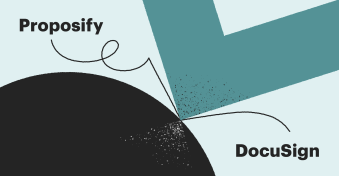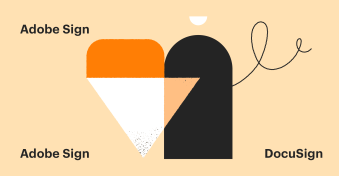Electronic signatures are an essential tool for modern businesses.
In addition to expediting the signing process, these tools help to ensure authentication, validity, and security for captured signatures.
It’s such a ubiquitous need that several e-signing platforms are available to facilitate this process. How do you find the best e-signature software?
Today, we’ll look at two well-equipped competitors: DocuSign and Signeasy.
Read on to learn how these competitors measure up to one another and which will be a better fit for your team.
Key takeaways
- DocuSign is considered an industry leader, but that reputation comes with increased prices and a narrow use case for DocuSign users.
- Signeasy lacks tertiary features when compared to DocuSign but has more flexible document restrictions and AI tools.
- Both platforms offer a similar signing workflow, experience, and user interface.
Signeasy
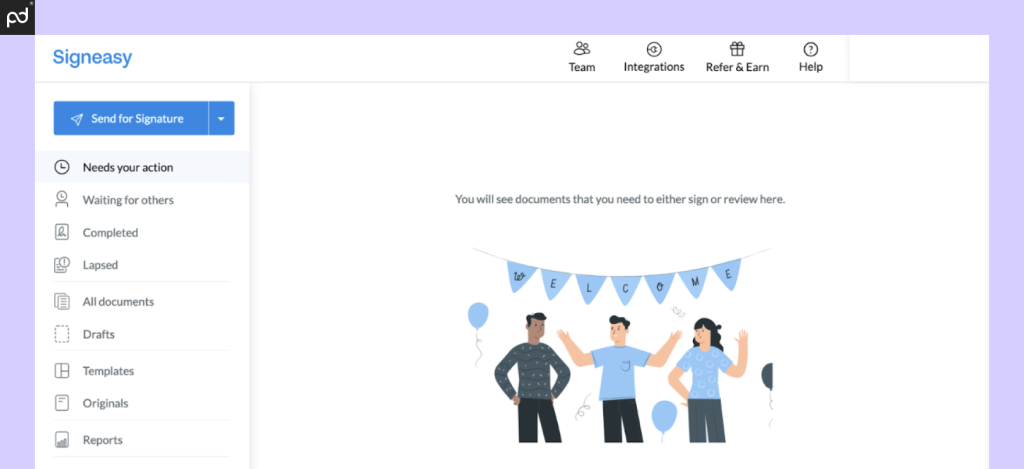
Pricing: Essential ($15); Team ($30; Business ($40); Business Plus ($60). Pricing based on month-to-month commitment.
Ease of use: 9/10
Free trial: Yes; 30 days.
Support: Knowledge base, email support.
Signeasy is an eSignature solution that gives individual users the ability to digitize paperwork, automate workflows, and improve efficiency in the document management process.
With Signeasy, it’s possible to create a securely signed document using your mouse, stylus, or finger, send documents for signatures anywhere in the world, and even collect signatures in person with just your mobile device (a key feature of the platform).
As you might expect from the name, Signeasy prides itself on having a simple, easy-to-use interface that works exceptionally well on any device.
They also incorporate AI tools to accelerate contract workflows while minimizing risk and ensuring compliance.
While these tools aren’t foolproof, they’re a preview of a more holistic focus on document management and contract negotiation — features that you’re unlikely to see in DocuSign’s standard e-signing tool.
DocuSign
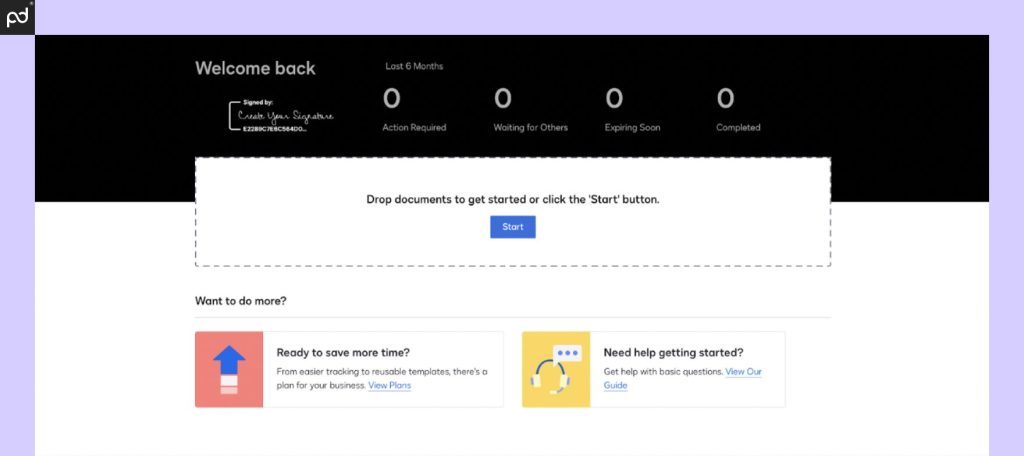
Pricing: Personal ($15); Standard ($45); Business Pro ($60). Enterprise pricing available. All pricing based on month-to-month commitment.
Ease of use: 9.0/10
Free trial: Yes; 30 days.
Support: Knowledge base; support tickets; additional support plans sold as separate packages.
As one of the original e-signature tools, DocuSign has been around since 2003 and is a global giant in the electronic signature industry.
It’s no wonder it remains one of the best e-signature software tools.
Its straightforward pricing model, user-friendly interface, and make it well-loved by small businesses and major corporations alike.
In addition to digital signatures, the company offers access to other digital tools like template automation, embedded form creation, payment processing, and much more.
For organizations that need document services that extend beyond digital signatures, DocuSign also offers additional products centered around contract lifecycle management (CLM) and document generation.
DocuSign continues to be a leading choice for companies large and small, as well as many government agencies around the globe.
Signeasy vs DocuSign at a glance
Looking for a rundown of how these two e-signing platforms compare?
Here’s a closer look at the premium plans offered by both companies.
| Plan Details | DocuSign | Signeasy |
|---|---|---|
| Plan Name | Business Pro | Business Plus |
| Core product | ||
| E-signature capture | ✓ | ✓ |
| Real-time audit trail | ✓ | ✓ |
| Notifications | ✓ | ✓ |
| Language support | ✓ | ✓ |
| Mobile app (Android / iOS) | ✓ | ✓ |
| Reporting tools | ✓ | ✓ |
| E-signing features | ||
| Signing order | ✓ | ✓ |
| Send to multiple recipients | ✓ | ✓ |
| Bulk send | ✓ | API Only |
| In-person signing | ✓ | ✓ |
| Collaboration tools | ✓ | Limited |
| Signer attachments | ✓ | ✓ |
| Payment gateway | ✓ | X |
| Document prep | ||
| Drag & drop fields (PDF) | ✓ | ✓ |
| Create reusable templates | ✓ | Unlimited |
| From-scratch document builder | X | X |
| Pre-built template library | X | ✓ |
| Form creation | ✓ | X |
| Custom branding | ✓ | ✓ |
| Integrations & API | ||
| Import & storage | ✓ | ✓ |
| CRM | X | ✓ |
| Productivity | ✓ | ✓ |
| API | $ | $ |
| Support | ||
| Email / ticketing support | ✓ | ✓ |
| Chat support | X | ✓ |
| Knowledge base | ✓ | ✓ |
| Phone | X | ✓ |
| Premium support options | $ | X |
Keep in mind that the chart above compares the most capable DocuSign and Signeasy solutions prior to escalating to an enterprise-level plan.
Both companies offer more cost-effective plans at a lower cost, and these options may be a better fit for individuals and smaller organizations who lack the need for the advanced features listed here.
DocuSign offers three plans before scaling to enterprise, excluding an unlisted free plan that acts as a perpetual free trial with some strict usage caps.
Signeasy offers four total plans, along with a limited free plan.
Notably, Signeasy’s “enterprise” solution is centered around per-document pricing rather than access to new features.
While considering your options to choose the best e-signature software, one factor to consider are transaction limits.
- DocuSign limits users to 100 envelopes per user/year.
- Signeasy restricts sending based on “fair usage” limits.
While it’s likely that Signeasy’s transaction limits are more flexible than the hard cap provided by DocuSign, this seems to be evaluated on a case-by-case basis.
Requirements, workflows & pricing
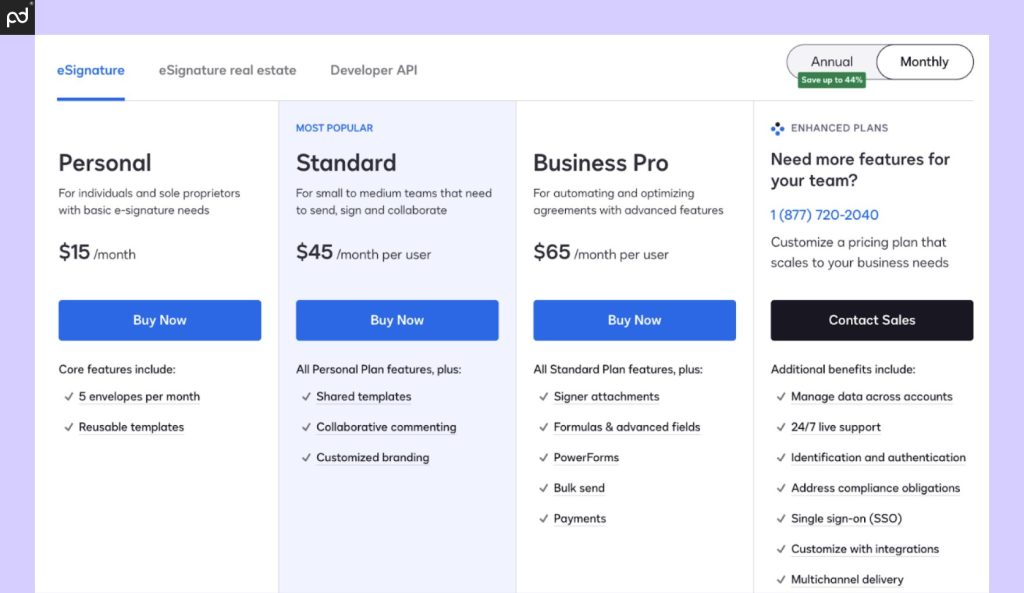
Both DocuSign and Signeasy provide similar approaches to document management and the e-signing process.
Each platform relies on a similar toolkit for document preparation.
Users will need to upload a document, prepare it for e-signing using drag-and-drop fields, then send it to designated signers using the intended platform.
While we found that the process is largely similar when using each tool, there were a few distinct differences.
Overall, DocuSign offers more features at each pricing tier than Signeasy, including payment gateways, commenting tools, and bulk sending capabilities for higher-end plans.
For example, DocuSign offers collaboration tools like commenting and feedback, but teams using the platform will still need to pull contracts back to a word processor to handle all but the smallest revisions.
This is different from PandaDoc, where users can edit and revise documents collaboratively within our live document editor.
If your billing system is set up to deliver invoices separately from your contracts — or if your invoices don’t require a digital signature — then the ability to capture payments through the DocuSign platform may not appeal to you.
This is true considering DocuSign’s transaction limits, which will limit the number of envelopes you can send to just 10/month and 100/year, even on the Business Pro plan.
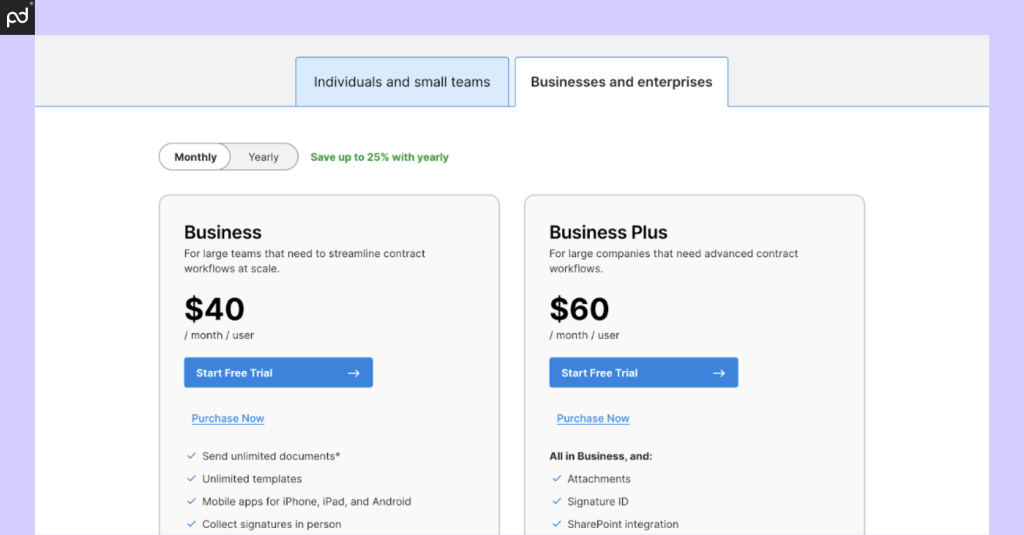
While Signeasy offers a more limited experience, those limitations may not be a major factor in your decision-making.
The platform still offers the same basic signing tools, including drag-and-drop fields, real-time audit trails, reminders, and more.
Though, it falls short on some of the niche features discussed above.
One of the key differences between the platforms in terms of workflow comes down to bulk sending.
While DocuSign users have access to this feature, Signeasy users will need a separate (paid) API subscription to access it.
On the other hand, Signeasy has been experimenting with bringing AI tools to the platform.
These features are designed to streamline document procedures, eliminate errors in your contracting process, and simplify the e-signing workflow.
You’ll also find access to several CRM integrations on Signeasy’s Business Pro plan.
These are tools that you won’t be able to get with DocuSign unless you upgrade to an enterprise-level plan. (More on this below.)
While DocuSign already offers similar features through DocuSign CLM, its contract lifecycle management solution, it’s clear that these features won’t be part of its standard e-signing tool.
In this way, Signeasy potentially brings more useful tools to bear on a well-established process.
That’s notable, considering that Signeasy is (generally) offered at a lower cost when compared to DocuSign.
Our suggestion
From the perspective of cost and workflow, when it comes to choosing the best e-signature software for you, we’d advise taking the time to consider if the exclusive features offered by DocuSign are actually worth the extra costs.
Likewise, if you need integration access, Signeasy is the obvious choice if you’re not willing to upgrade to an enterprise plan.
Take the time to evaluate your own workflow and assess whether DOcuSign’s features can contribute to your brand.
If not, Signeasy may be the better option.
Final verdict:
- DocuSign offers a broader feature set that will only be useful to select workflows.
- Signeasy lacks the appealing functionality around payment gateways and bulk sending but offers integrations and some AI tools that DocuSign users can only acquire with higher costs.
- PandaDoc offers robust features, a wide selection of integrations, and no transaction/send limits, making it a great alternative for many users.
Integrations
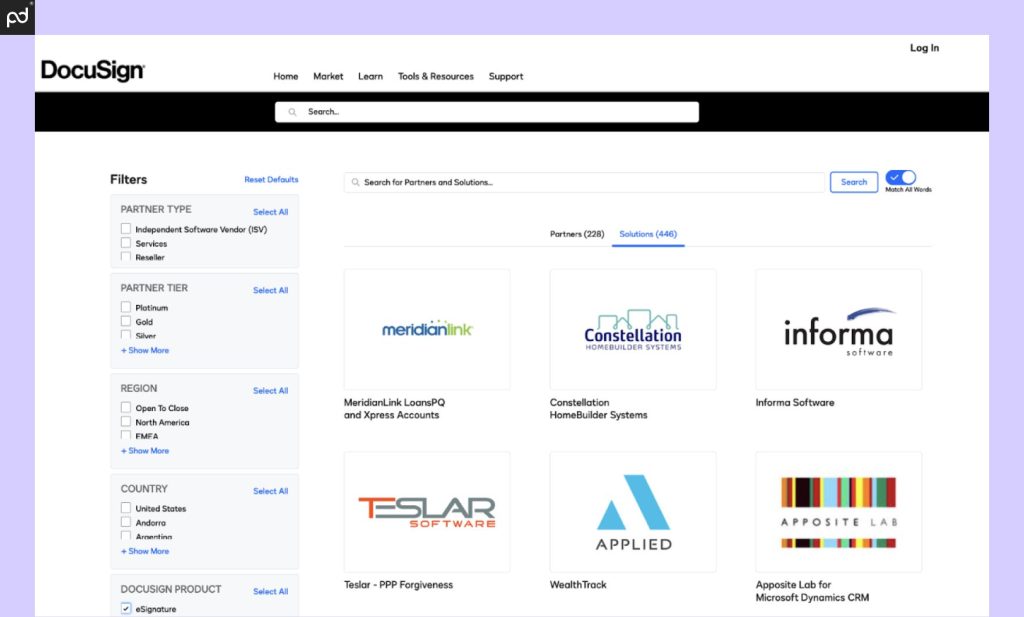
Because integrations function differently between DocuSign and Signeasy, we wanted to take a closer look at what each brand has to offer.
In a contest of numbers, DocuSign is the clear winner.
The company offers 400+ integrations, including connectors with niche product solutions that teams won’t find anywhere else.
Overall, DocuSign splits its integrations into a variety of categories, including “storage”, “productivity”, and “workplace.”
The majority of these integrations are available on the Standard and Business Pro plans, and they allow users to connect to tools like Dropbox, Google Drive, Microsoft Teams, Zoom, or Google Workspace.
However, DocuSign’s unique categories are its partner integrations.
These integrations are available on all plans and are largely designed to connect with specific programs and services.
We’ve seen integrations for specific HR tools, select automotive CRMs, and other obscure solutions.
They’re very specific, but it’s likely that you’ll only find one or two of these integrations valuable, contingent upon the other software that you use to operate your business.
DocuSign’s second major integration category is its standard CRM integration suite.
This includes connectors for Salesforce, Microsoft Dynamics, Netsuite. These integrations are only available on an Enhanced (enterprise) plan.
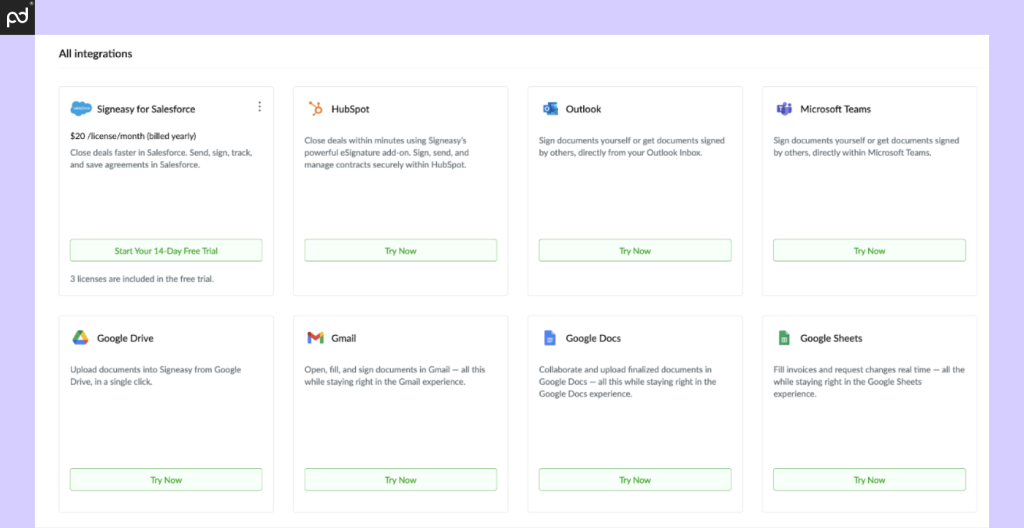
In total, Signeasy lists nine integrations on its website, including connections for HubSpot, Google Workspace, Microsoft Outlook, and a few others.
Although it’s not listed publicly, it’s also possible to purchase a Salesforce connector for an additional monthly charge.
Our suggestion
While we aren’t saying that Signeasy’s integration landscape is robust or can’t be improved, it’s likely to be a good fit for teams who don’t need the custom connection options offered by DocuSign.
If you have a very specific business tool, having an e-signature software that integrates natively to existing solutions can be a major upgrade, in the right circumstances.
Final verdict:
- DocuSign offers a wider range of integration, but the most desirable CRM connectors are only available on enterprise plans.
- Signeasy’s integration tools are more limited but are available for a lower cost and may still be a good fit for many users.
- PandaDoc offers a good middle ground with more integrations than Signeasy but without the need to upgrade to the Enterprise level for most popular CRM connectors.
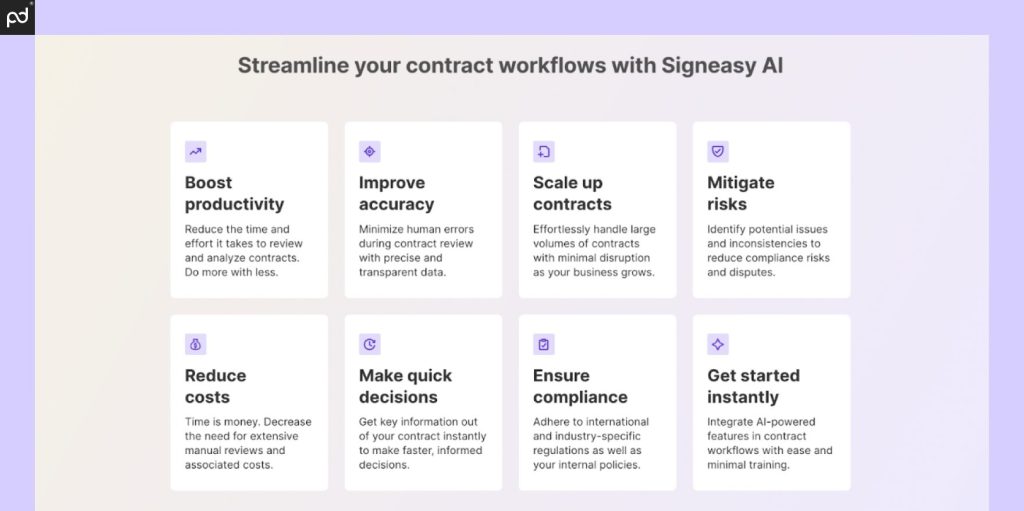
Templates & automations
Document automation is a critical component of the e-signing process, and it’s one where we see key differences between DocuSign and Signeasy.
For this comparison, we’re considering automation to be anything that helps you more easily skip and streamline repeatable steps in the signing process.
Users on all DocuSign plans can create reusable templates, expediting the e-signing process for regularly sent documents like onboarding forms, invoices, or NDAs.
It’s also possible to create locked templates on the Business Pro plan for safer sharing across team accounts.
Signeasy users can create reusable templates.
The platform even offers reusable templates similar to those in the PandaDoc template library to help users jumpstart their e-signing journey.
Where Signeasy takes things a step further is with its newer AI features. Signeasy AI integrates with the Signeasy UI to assist with contract customization at scale.
The tool can summarize contract information, point out key terms, and help to mitigate risks caused by human error.
DocuSign offers similar tools, but these are only made available through DocuSign CLM, an entirely separate program from their e-signing solution.
Our suggestion
Automation tools can be extremely helpful when trying to streamline your document and contracting workflows.
For most e-signing tools, automation comes down to the ability to create templates for commonly used documents and forms, which cuts down on preparation time when sending those items.
AI also plays a role here, but its usefulness will vary, depending on your organizational workflow.
Final verdict:
- DocuSign offers template creation tools for both documents and forms (PowerForms are essentially templated documents that can be embedded on a website), allowing for fast and easy streamlining of commonly used documents.
- Signeasy allows for template creation but also leverages AI tools and a template library to take this process beyond what’s available in the DocuSign e-signing platform.
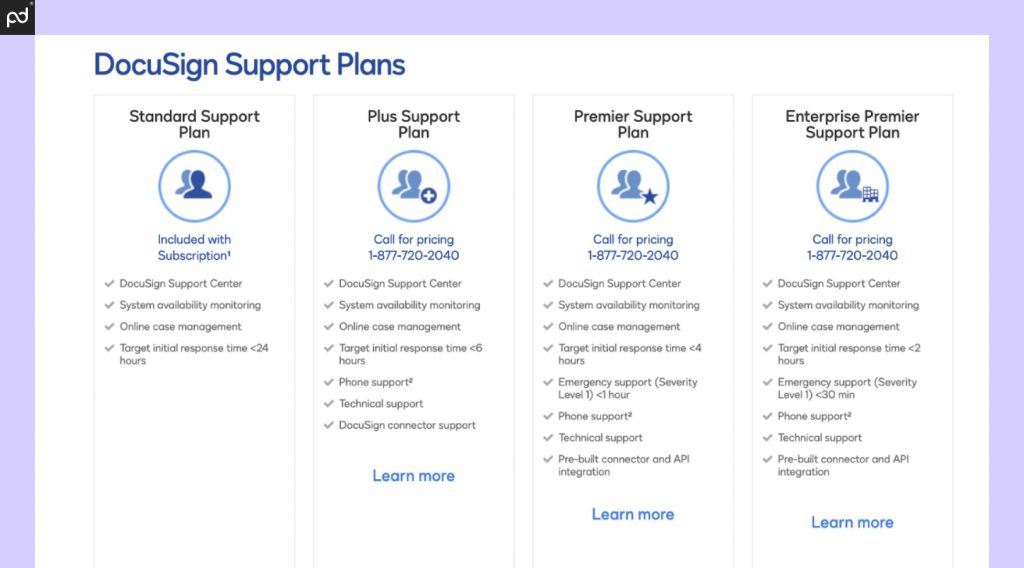
Customer support
While both DocuSign and Signeasy offer customer support for troubleshooting, each brand approaches this topic in very different ways.
DocuSign offers its Standard support package to every user, which includes a knowledgebase and ticketing system with a (targeted) 24-hour response time.
If you need help and you’re on the Standard plan, expect a rep to get back to you within about a day.
If you need faster or additional support options, DocuSign offers three additional (paid) plans, which can give access to telephone support and priority escalations with much lower response time.
At the highest tier, critical issues will get a support response within 30 minutes.
By contrast, Signeasy takes a different approach and assigns support options by plan type.
While the bottom-tier “Essentials” plan only gets email support, all other plans offer 24/7 chat support (similar to what PandaDoc offers for all plans).
Business plans also feature phone support and a customer success manager dedicated to help your team succeed.
The best part: None of Signeasy’s support options require an additional plan or service charge.
Rather than offering a premium plan, Signeasy includes access to fast support options as part of your plan and experience.
That’s a huge difference, especially when things go wrong.
Our suggestion
At PandaDoc, we offer 24/7/365 support via chat for all plans while offering premium support packages available for customers who need a little extra help.
We understand what both DocuSign and Signeasy have implemented with their support strategies.
At the end of the day, we’ve always felt that it’s better for customers to get access to the support they need as fast as possible.
It’s what we do for our own customers, and we always appreciate seeing brands like Signeasy offering minimal delays when users have problems.
Final verdict:
- DocuSign’s basic support tier offers some help, but expect a lengthy delay before your issue is resolved. At higher (paid) tiers, you’ll see faster response times and a support infrastructure that can work well for enterprise teams.
- Signeasy offers 24/7 chat support for most of its plans, as well as a dedicated account manager and phone support at the higher tier. You’ll be able to get help and get back to work quickly — a huge benefit when time is money.
Alternatives to Signeasy & DocuSign
While both DocuSign and Signeasy are great options for the right team, they aren’t the only e-signing solutions on the market today.
Here’s a quick list of a few Signeasy/DocuSign alternatives:
- PandaDoc.
- Dropbox Sign.
- Adobe Acrobat Sign (formerly Adobe Sign).
- SignNow.
- SignRequest.
While picking the right best e-signature signature software for your team is ultimately a personal decision, the best DocuSign alternative might not be Signeasy.
If you’re still looking for something that meets your business needs, we’d recommend giving PandaDoc a try if you’re unsure where to start.
With PandaDoc, you can create unlimited documents entirely from a blank page using our onboard editor, conduct live collaborations with team members and signing partners, and much more.
Combined with powerful integration and branding options, it’s a powerful tool that can cover your entire document workflow.
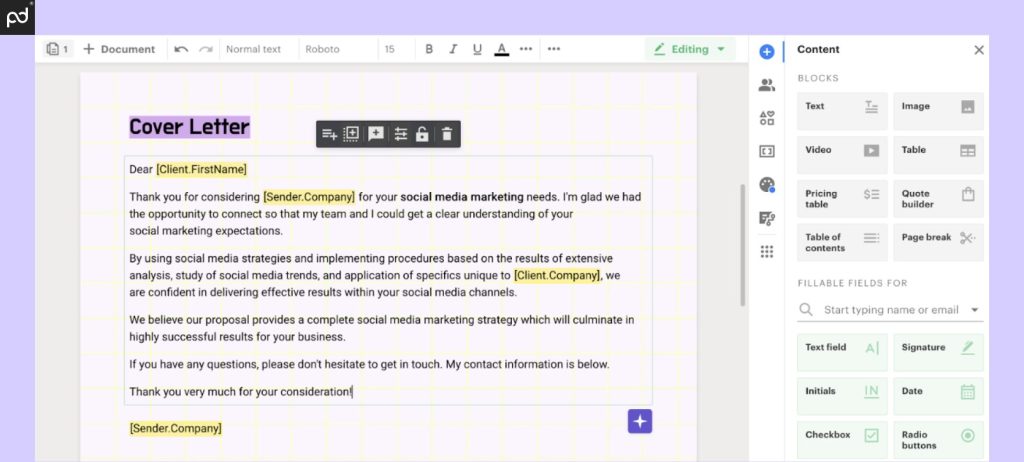
The ultimate e-signing solution
As a larger company, DocuSign has more to offer in the way of integrations and features, but its usage caps can limit its effectiveness for power users.
Meanwhile, Signeasy provides similar tools for lower costs and with less-restrictive usage caps, making it a good alternative.
But, in our view, you can’t really beat PandaDoc.
We offer:
- From-scratch document creation.
- Pre-built template libraries.
- No usage caps or sending limits.
- 24/7/365 chat support for all plans.
- Collaborative e-signing workflows.
- Robust integration options.
One of the best ways to figure out if an e-signature software is right for you is a trial period.
Sign up for a free 14-day trial or a live demo to see for yourself how the PandaDoc platform can become the perfect solution for your business.
Disclaimer
Parties other than PandaDoc may provide products, services, recommendations, or views on PandaDoc’s site (“Third Party Materials”). PandaDoc is not responsible for examining or evaluating such Third Party Materials, and does not provide any warranties relating to the Third Party Materials. Links to such Third Party Materials are for your convenience and does not constitute an endorsement of such Third Party Materials.
Originally published September 23, 2022, updated December 13, 2024
